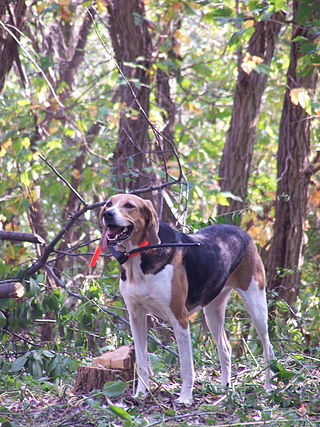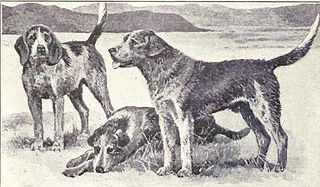Related Research Articles

The Harrier is a medium-sized dog breed of the hound class, used for hunting hares by trailing them. It resembles an English Foxhound but is slightly smaller, though not as small as a Beagle. The breed has been used since the mid 13th century.

Fox hunting is a traditional activity involving the tracking, chase and, if caught, the killing of a fox, normally a red fox, by trained foxhounds or other scent hounds. A group of unarmed followers, led by a "master of foxhounds", follow the hounds on foot or on horseback.

A foxhound is a type of large hunting hound bred for strong hunting instincts, a keen sense of smell, and their bark, energy, drive, and speed. In fox hunting, the foxhound's namesake, packs of foxhounds track quarry, followed—usually on horseback—by the hunters, sometimes for several miles at a stretch; moreover, foxhounds also sometimes guard sheep and houses.
The League Against Cruel Sports, formerly known as the League for the Prohibition of Cruel Sports, is a UK-based animal welfare charity which campaigns to stop blood sports such as fox hunting, hare and deer hunting; game bird shooting; and animal fighting. The charity helped bring about the Hunting Act 2004 and Protection of Wild Mammals (Scotland) Act 2002, which banned hunting with hounds in England, Wales and Scotland.

Beagling is mainly the hunting of hares and rabbits by beagles using their strong sense of smell. A beagle pack is usually followed on foot, but in a few cases mounted. Beagling is often enjoyed by 'retired' fox hunters who have either sustained too many injuries or lost the agility to ride horseback, or who enjoy the outdoors and the camaraderie of the hunt. It is also traditionally a way for young men and women to learn how to handle hounds on a smaller scale before they go on to hunt with foxhounds.

The Hunting Act 2004 is an Act of the Parliament of the United Kingdom which bans the hunting of most wild mammals with dogs in England and Wales, subject to some strictly limited exemptions; the Act does not cover the use of dogs in the process of flushing out an unidentified wild mammal, nor does it affect drag hunting, where hounds are trained to follow an artificial scent.
Hunt sabotage is the direct action that animal rights activists and animal liberation activists undertake to interfere with hunting activity.
Legislation on hunting with dogs is in place in many countries around the world. Legislation may regulate, or in some cases prohibit the use of dogs to hunt or flush wild animal species.
Hunt Terrier refers to types of terrier dogs that were attached to British "hunts", horse-oriented social clubs devoted to chasing the red fox on horseback, following packs of hounds. The hunt terrier was kept for a variety of reasons, such as rat control around stables and kennels, and to run with the hounds to flush the fox from small hiding places. It might also be expected to flush foxes from underground dens, or to act as a lurcher. They tended to be white in colour so as to be more easily seen by the hunter, but they could be any colour.

Charles Frederick Otis Ferry is a British model and pro-fox hunting enthusiast. He has served as joint master of the South Shropshire hunt.

The Welsh Hound is a breed of hunting dog of the foxhound type, indigenous to Wales.

The Grand Anglo-Français Blanc et Noir translated into English as the Great Anglo-French White and Black Hound, is a breed of dog used in hunting as a scenthound, usually in packs. It is one of the Anglo-French hound breeds which were created by crossing French scenthounds with English (Anglo) Foxhounds.

The Quorn Hunt, usually called the Quorn, established in 1696, is one of the world's oldest fox hunting packs and claims to be the United Kingdom's most famous hunt. Its country is mostly in Leicestershire, together with some smaller areas of Nottinghamshire and Derbyshire.

The Cottesmore Hunt, which hunts mostly in Rutland, is one of the oldest foxhound packs in Britain, with origins dating back to 1666. Its name comes from the village of Cottesmore where the hounds were kennelled.
The Bluecap Memorial stands in the yard of the Cheshire Hunt Kennels in Kennel Lane, Sandiway, Cheshire, England. Bluecap was a Cheshire foxhound that was famous for winning a race against the hounds of Hugo Meynell of the Quorn Hunt in 1763. The memorial is in sandstone and consists of an obelisk standing on a plinth, with a brass plaque inscribed with a poem. It is recorded in the National Heritage List for England as a designated Grade II listed building.

In the United Kingdom, hunt monitors endeavour to observe behaviours of organized hunts and undertake information gathering activities, known as hunt monitoring.

The Warwickshire Hunt is an English fox hunting pack founded in 1791.
The Essex and Suffolk Hunt is an English fox hunting pack founded in 1791.
The Duke of Buccleuch's Hunt is a fox hunt which hunts in the Scottish Borders area of Scotland.

The Staghound, sometimes referred to as the English Staghound, is an extinct breed of scent hound from England. A pack hound, the breed was used to hunt red deer and became extinct in the 19th century when the last pack was sold.
References
- 1 2 3 "Crawley and Horsham". Master of Foxhounds Association. Archived from the original on 30 November 2009. Retrieved 1 April 2010.
- ↑ "Hunting countries of UK and Ireland". BBC News. 16 September 1999.
- 1 2 "The Crawley and Horsham - A History". 1965.
- ↑ "A positive future for the Crawley and Horsham Hunt". 15 February 2021.
- ↑ "Crawley and Horsham Hunt Branch of the Pony Club". The Pony Club. Archived from the original on 15 January 2010.
- ↑ "Crawley and Horsham Hunt thug convicted". 11 October 2007.
- ↑ "Hunt's legal fight against saboteurs 'will be nasty'". 25 July 2008.
- ↑ The Daily Telegraph
- ↑ "Hunt's court action is adjourned". BBC News. 22 October 2008.
- ↑ Tibbetts, Graham (28 July 2008). "Fox-hunting High Court case halted by judge who supported ban as a Labour MP". The Daily Telegraph. London.
- 1 2 "Sussex hunt drops court case against activists". 16 July 2009.
- ↑ "Call off the hounds!". Archived from the original on 29 October 2013. Retrieved 1 January 2013.
- ↑ White, Charlotte (25 July 2009). "Crawley & Horsham hunt drops fight against saboteurs". Horse and Hound. Archived from the original on 4 October 2012.
- ↑ "Pepper spray used by police during Sussex hunt protest clashes". 8 February 2011.
- ↑ "Crawley and Horsham Hunt supporter convicted".
- ↑ Bowcott, Owen (14 May 2012). "Hunt members found guilty of illegally pursuing fox with hounds". The Guardian. London.
- ↑ Bingham, John (24 August 2011). "Hunting ban put to test as four face court in landmark case". London: The Daily Telegraph. Archived from the original on 24 August 2011.
- ↑ "Sussex man admits illegal fox hunting". The Argus. 19 September 2013.
- ↑ "Hunt master threatened to 'ram' bugle down throat of saboteur he thought had kidnapped his dog". The Daily Telegraph . 11 October 2017. Archived from the original on 1 June 2022.
- ↑ / https://www.thecanary.co/feature/2019/03/02/an-activist-whose-life-was-made-unbearable-by-a-tory-mp-linked-hunt-speaks-out-about-her-ordeal/
- ↑ "West Grinstead huntsman cleared of illegal fox hunting". BBC News. 10 March 2021.